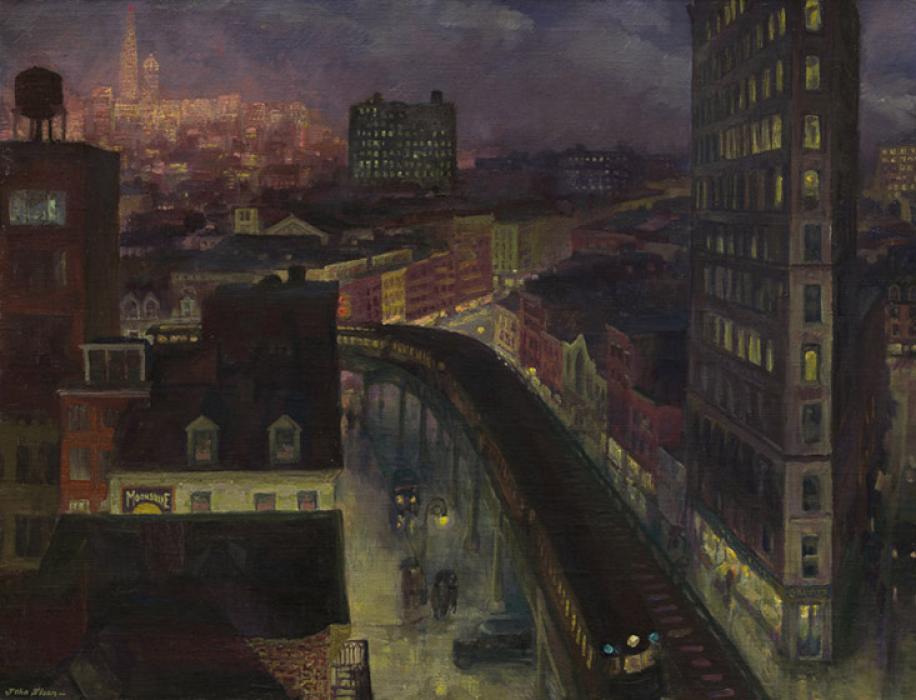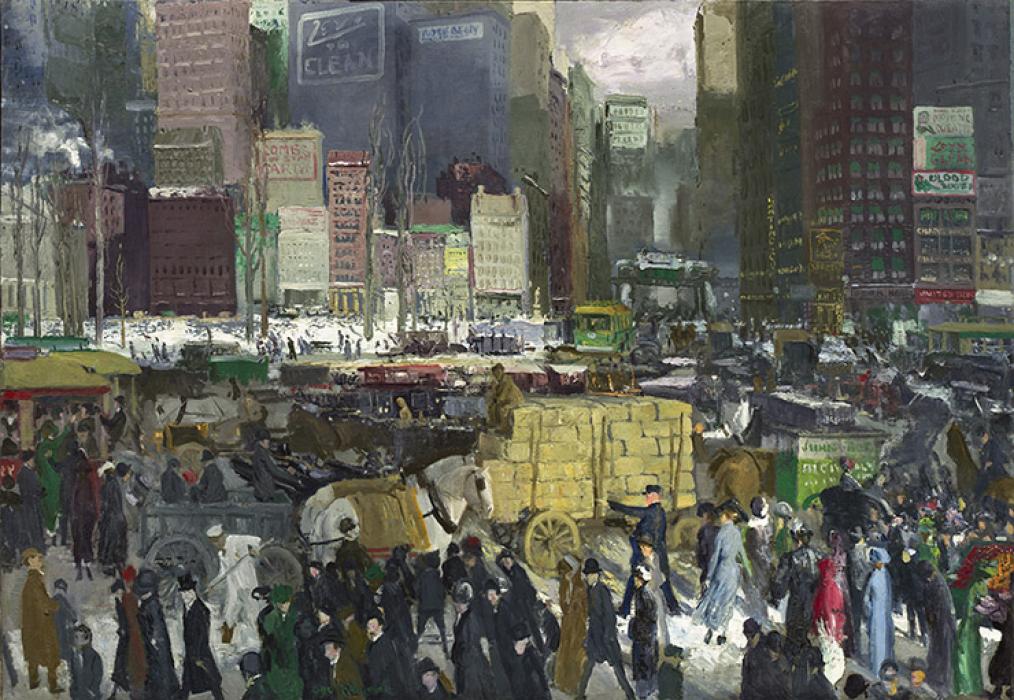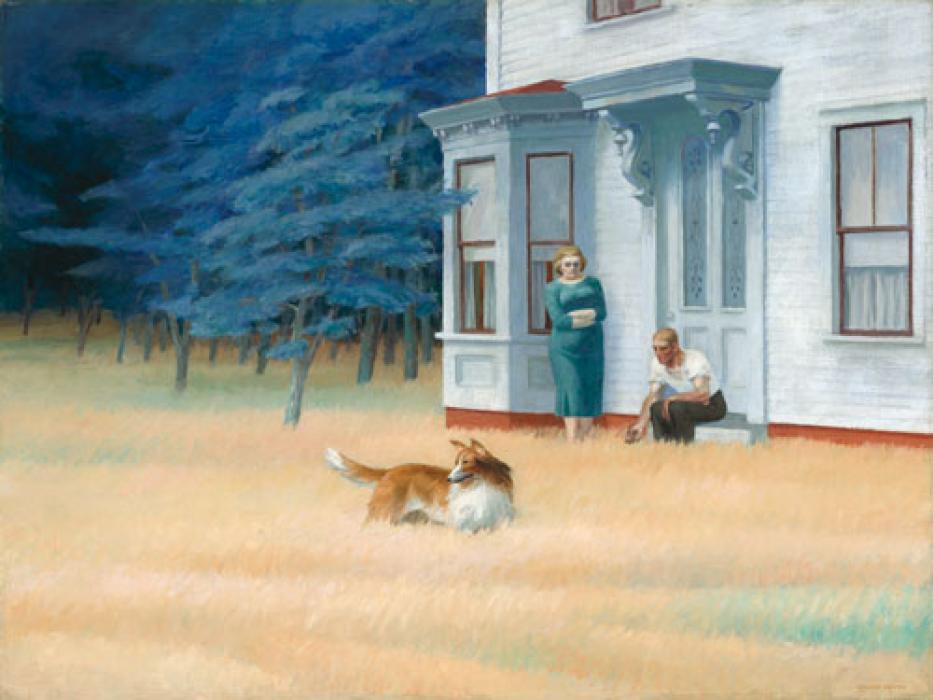Building the Collection: Robert Henri and His Circle
Chester Dale’s astute early gift of George Bellows’s Both Members of This Club in 1944 cleared the path for paintings by Robert Henri and many of his other talented students and contemporaries traditionally associated with The Eight or the Ashcan school of urban realism, to enter the collection. In addition to Henri himself, numerous works by five of his cohorts from The Eight—John Sloan, Arthur Davies, Maurice Prendergast, George Luks, and William Glackens—and a quartet of his most successful acolytes—Bellows, Guy Pène du Bois, Edward Hopper, and Rockwell Kent—were eventually acquired. Henri’s Whistlerian Young Woman in White and his vivid portrait of an Irish child, Catherine, became part of the permanent collection 20 years after the artist’s death. These gifts were followed in 1954 by one of Henri’s most absorbing urban landscapes, Snow in New York, courtesy of Chester Dale, and another full-length female portrait in 1956, Edith Reynolds, given by the sitter. Henri’s debt to Dutch painting is evident in a 1973 gift, Volendam Street Scene. And in 1986, his incisive portraits of George Cotton Smith and his wife, Elizabeth Virginia Lanning Bradner Smith, were donated by the Smith family. The Avalon Foundation funded the purchase of the Gallery’s first work by Luks in 1950, the patriotic World War I subject The Bersaglieri. And in 1954, Dale, again mindful of the 20-year rule, donated Luks’s powerful, unflinching portrait of the American workingman, The Miner.

Fig. 1 John Sloan, The City from Greenwich Village, 1922, oil on canvas, National Gallery of Art, Washington, Gift of Helen Farr Sloan
Fig. 1 John Sloan, The City from Greenwich Village, 1922, oil on canvas, National Gallery of Art, Washington, Gift of Helen Farr Sloan
In a very different vein, Davies’s esoteric allegory of physical beauty and mystical transcendence, Sweet Tremulous Leaves, was included in Dale’s 1963 bequest. In 1970, John Sloan’s daughter donated her father’s nocturnal evocation of the great modern city of New York as seen from the unusual viewpoint of one of its most notoriously bohemian, marginalized enclaves: The City from Greenwich Village [fig. 1]. Rounding out the Gallery’s representation of The Eight are a painting by William Glackens featured in the epochal 1913 Armory Show in New York, Family Group, given by his son Ira in 1971, and a signature work by Prendergast donated by Mr. and Mrs. Paul Mellon in 1971, Salem Cove.
In addition to his contributions as an artist, Robert Henri was perhaps the most influential teacher of his era. Among the successive waves of students who fell under the spell of his inspirational, all-encompassing mantra of “art for life’s sake” at the New York School of Art were four of the most talented members of the first-generation of American modernists: Bellows, Hopper, and Kent, all born in 1882, and Pène du Bois, born in 1884. Among the 1963 Dale bequest were two Parisian subjects by Pène du Bois from the late 1920s, a time when many American modernists were drawn to France, Café du Dome and La Rue de la Sante, as well as two New York scenes, Hallway, Italian Restaurant (1922) and an early work from circa 1912, The Politicians. All of these convey the artist’s fascination with the shadowy, elusive encounters of modern urban life.

Fig. 2 George Bellows, New York, 1911, oil on canvas, National Gallery of Art, Washington, Collection of Mr. and Mrs. Paul Mellon
Fig. 2 George Bellows, New York, 1911, oil on canvas, National Gallery of Art, Washington, Collection of Mr. and Mrs. Paul Mellon
The group of five paintings by Bellows donated by Mr. and Mrs. Paul Mellon in 1983 and 1986, together with the Dale gifts, gave the Gallery outstanding representative works from across the artist’s career, and made its Bellows collection the strongest in the country. Little Girl in White (Queenie Burnett) (1907) is a harrowing portrayal of a young child laborer, a laundress, disconcertingly sitting for a formal portrait in the artist’s studio. New York [fig. 2] is one of Bellows’s most ambitious attempts to capture the multiplicity of the modern city. In addition, three later works demonstrated Bellows’s restless search for new subjects and styles. My Family (1916), a domestic tableau, and Tennis Tournament (1920), a scene of high society at a casino and tennis club in Newport, are both unfinished works in progress. Nude with Hexagonal Quilt, with its uneasy blend of Old Master allusions and folksy eroticism, was painted in Bellows’s Woodstock studio in 1924 shortly before his death.

Fig. 3 Edward Hopper, Cape Cod Evening, 1939, oil on canvas, National Gallery of Art, Washington, John Hay Whitney Collection
Fig. 3 Edward Hopper, Cape Cod Evening, 1939, oil on canvas, National Gallery of Art, Washington, John Hay Whitney Collection
The bequest from the John Hay Whitney Collection in 1982 included a quintessential boxing subject by Bellows, Club Night, and the first painting by Hopper to enter the collection, Cape Cod Evening [fig. 3].[1] The juxtaposition illuminated the intertwined destinies of the two artists. Club Night epitomizes the youthful notoriety of the dynamic action painter Bellows in the first decades of the century. This stands in stark contrast to a painting like Cape Cod Evening and his friend Hopper’s slow ascent, beginning in the 1920s, to national and international fame as the painter of emptiness and stasis. Finally, an important painting of Greenland by the most controversial and iconoclastic of all of Henri’s followers, Rockwell Kent, entered the collection in 2013 as a gift from Edward and Deborah Shein.[2] The Citadel, a monument of isolation, hints at the complex personality of a painter who was as embroiled with the heated national political issues of the day as he was detached and geographically distanced from them.
Notes
[1] The 1982 Whitney gift also included works by Henri Edmond Cross, André Derain, Henri Rousseau, James McNeill Whistler, and Thomas Eakins.
[2] See Charles Brock and Nancy Anderson, American Modernism: The Shein Collection (Washington, DC, 2010).


